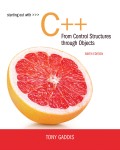
Concept explainers
Explanation of Solution
“cstdlib” header file:
`
The C++ library contains many functions for string/numeric conversions; The “cstdlib” header file must be used for converting C-string and string value to numeric data type and vice versa.
The “atoi” and “atof” functions must need “cstdlib” header file for converting string to numeric data type.
- atoi – it converts C-string argument to integer value.
- atof – it converts C-string argument to double value.
“atoi” function:
In C++, the predefined function “atoi” is used to convert a string value into an integer value; it passes a string literal or character array as an argument and it converts the received value into an integer value; it takes only one parameter as an argument.
- If the argument value contains nonconvertible contents combined with the integer value then the values will be ignored while converting.
- In same way, the function will return “0” when the values can’t be able to convert into double data type.
Syntax:
The syntax for the “atoi” function is as follows:
int atoi (const char* n);
In the above statement,
- “int” represents the return type of the function.
- “atoi” represents the name of the function.
- “const char*” represents the data type of the passing argument.
- “n” is a string variable which is required to be converted.
Example:
The example for the “atoi” function is as follows:
//change the string literal to an int value
int n = atoi("123456 hai");
In the above line, the string literal “123456 hai” is passed as an argument to “atoi” and it returns the converted value that is “123456”; here the “atoi” function ignores the whitespace and the nonconvertible value “hai”...
Want to see the full answer?
Check out a sample textbook solution
Chapter 10 Solutions
EBK STARTING OUT WITH C++ FROM CONTROL
- 2:21 m Ο 21% AlmaNet WE ARE HIRING Experienced Freshers Salesforce Platform Developer APPLY NOW SEND YOUR CV: Email: hr.almanet@gmail.com Contact: +91 6264643660 Visit: www.almanet.in Locations: India, USA, UK, Vietnam (Remote & Hybrid Options Available)arrow_forwardProvide a detailed explanation of the architecture on the diagramarrow_forwardhello please explain the architecture in the diagram below. thanks youarrow_forward
- Complete the JavaScript function addPixels () to calculate the sum of pixelAmount and the given element's cssProperty value, and return the new "px" value. Ex: If helloElem's width is 150px, then calling addPixels (hello Elem, "width", 50) should return 150px + 50px = "200px". SHOW EXPECTED HTML JavaScript 1 function addPixels (element, cssProperty, pixelAmount) { 2 3 /* Your solution goes here *1 4 } 5 6 const helloElem = document.querySelector("# helloMessage"); 7 const newVal = addPixels (helloElem, "width", 50); 8 helloElem.style.setProperty("width", newVal); [arrow_forwardSolve in MATLABarrow_forwardHello please look at the attached picture. I need an detailed explanation of the architecturearrow_forward
- Information Security Risk and Vulnerability Assessment 1- Which TCP/IP protocol is used to convert the IP address to the Mac address? Explain 2-What popular switch feature allows you to create communication boundaries between systems connected to the switch3- what types of vulnerability directly related to the programmer of the software?4- Who ensures the entity implements appropriate security controls to protect an asset? Please do not use AI and add refrencearrow_forwardFind the voltage V0 across the 4K resistor using the mesh method or nodal analysis. Note: I have already simulated it and the value it should give is -1.714Varrow_forwardResolver por superposicionarrow_forward
- Describe three (3) Multiplexing techniques common for fiber optic linksarrow_forwardCould you help me to know features of the following concepts: - commercial CA - memory integrity - WMI filterarrow_forwardBriefly describe the issues involved in using ATM technology in Local Area Networksarrow_forward
 C++ for Engineers and ScientistsComputer ScienceISBN:9781133187844Author:Bronson, Gary J.Publisher:Course Technology PtrProgramming Logic & Design ComprehensiveComputer ScienceISBN:9781337669405Author:FARRELLPublisher:Cengage
C++ for Engineers and ScientistsComputer ScienceISBN:9781133187844Author:Bronson, Gary J.Publisher:Course Technology PtrProgramming Logic & Design ComprehensiveComputer ScienceISBN:9781337669405Author:FARRELLPublisher:Cengage C++ Programming: From Problem Analysis to Program...Computer ScienceISBN:9781337102087Author:D. S. MalikPublisher:Cengage Learning
C++ Programming: From Problem Analysis to Program...Computer ScienceISBN:9781337102087Author:D. S. MalikPublisher:Cengage Learning Microsoft Visual C#Computer ScienceISBN:9781337102100Author:Joyce, Farrell.Publisher:Cengage Learning,
Microsoft Visual C#Computer ScienceISBN:9781337102100Author:Joyce, Farrell.Publisher:Cengage Learning, Programming with Microsoft Visual Basic 2017Computer ScienceISBN:9781337102124Author:Diane ZakPublisher:Cengage Learning
Programming with Microsoft Visual Basic 2017Computer ScienceISBN:9781337102124Author:Diane ZakPublisher:Cengage Learning





